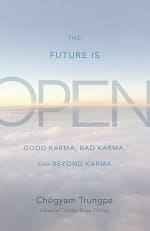Karma is one of those topics that seems so obvious on the surface and then becomes a completely befuddled mess when you scratch beneath it. We all seem to feel some kind of cosmic justice is at work in our lives, and everyone from my dad to Gandhi has ascribed to some form of “what goes around comes around,” or “you reap what you sow.”
This Sanskrit word with nuanced meaning in Hindu and Buddhist tradition has long since entered the vernacular, beginning at least with John Lennon’s lyric “instant karma’s gonna get you” or Boy George’s “karma, karma, karma, karma, karma chameleon.” There’s even one of those British joke signs: “Keep Calm and Let Karma Finish It.” A wildly familiar concept, and yet, what does it really mean? If past actions, even from previous lives, are having effects today, by what means is that carried out? Where is the universal Amazon.com that stores and distributes the fruits of our good and bad deeds? Am I guilty of giving myself this disease?
If you’re searching for final answers to these abstract Religious Studies 101 questions, you won’t find them in The Future is Open: Good Karma, Bad Karma, and Beyond Karma by Chögyam Trungpa. What you will experience here is having the rug pulled out from under you once again, as you are asked to explore what is the origin of any action you take, what are its consequences, and how you understand past, present, and future. It’s a phenomenological journey into the moment, a manual for practitioners. And it makes clear that sorting out the mechanisms of karma—the how and why I got here—is not the point, nor is figuring out how to develop good karma in order to outfox the cosmic scorekeeper. The point is how to be free in the moment, and even to transcend karma. We are indeed constrained by causes and conditions, but as the title suggests, what happens now is not predestined. As Trungpa Rinpoche says, the future is “open space and freedom.”
Editor Carolyn Gimian has pulled together readings from diverse sources to present a kind of Chögyam Trungpa karma compendium in 13 chapters. “The Karma Seminar” (Karme-Choling, September 1972), which formed the basis of a well-used sourcebook, provides four of the chapters, and several other talks on karma from the early 70’s contribute a few more. Other chapters are from previously published material, including chapters from Volume 1 of The Profound Treasury of the Ocean of Dharma, which itself is drawn from talks given at Vajradhatu Seminaries from 1973 to 1986.
It is a quilt of many colors, Gimian admits, and yet it hangs together quite beautifully as a book. It’s a satisfying read that will likely cause you to stop and re-read many a passage. To wit, here is one spot I highlighted in chapter 9, “Choiceless Choice”:
“In dealing with your psychological state, you need ground and stepping- stones that help you find ways to work with yourself. In this case, the ground is based on freedom from the past and the freedom of the present. Unless we recognize and embrace that freedom, there’s no way of relating with karma at all.” [emphasis added]
He makes this point after noting “our psychological tendency to feel trapped by hang-ups from our past,” which can give us the feeling that there is little hope. What can counteract that is the understanding that in this very moment, “Where you go from here is purely up to you.”
This is the credo at the heart of The Future is Open, and it’s an encouraging one. We always begin again. Square One is our destiny.
The book is in three parts. Part One, The Birth of Karma, begins with a previously unpublished 1972 talk, simply called “Karma”, from New York City. It starts off with a bang, and several sections merit re-reading slowly. For example, “Buddha activity, or the enlightened energy, is referred to as karma. The samsaric confused pattern, the chain reaction of confusion, is also referred to as karma. So, altogether when we discuss karma, we are discussing energy.” Right off the bat, we know we’re not talking about the popular notion of predetermined outcomes and retribution. This section continues in an analysis of how dualism emerges: “…you have a sense of ‘this’ as the instigator of the whole thing…. Then, the natural, almost automatic reaction is that ‘this’ situation is secured, attacked, or entertained by ‘that.’”
This ping-pong match we indulge in is “the basic karmic situation,” a kind of trap. The good news comes soon thereafter. There are gaps! We cannot “rest in one-pointedness,” so long as we bounce from this to that and back again, but what appears to us as continuous is not and within the gaps (what in a later chapter he refers to brilliantly as “the nonexistence of the ongoingness”), “the dualistic psychological hang-up does not continue.”
Many interesting insights and explanations later, the section ends with a discussion of unconditionality—a potent term that does not fit within the realm of spell-check. He makes the point that when you do something arising from belief in your separateness, you reinforce that separateness, but if, “for a moment, you do something that is not based on a belief in separateness, if it’s not based on thoughts that have any kind of prerequisite or dependency, then your activity ceases to be karmic.” And, further, he says, the weight of heavy karma from the past cannot undermine our Buddha nature. “Sooner or later, it’s going to break through.” In fact, he says there’s no choice in that matter. It will break through at some point. This is a book on karma that keeps circling back to good news.
Part Two, “The Painful Reality of Samsara,” delivers a detailed picture and blueprint in four chapters of the samsaric mess, including reviews of the 12 nidanas, the 6 realms, and the 6 root kleshas. It’s a sobering journey through the karmic truth of cause and effect, wherein Trungpa Rinpoche reiterates the manual labor required on the path. We need the practice of meditation. We cannot topple the brick wall of samsara in one heroic push. “If you want to take the wall down, you have to work brick by brick.” And later on, in encouraging us to be honest about persistent karmic patterns, “we should stick to facts and figures, to what we are going through in our life. We are all subject to these problems, and we ought to realize that and try to understand it.” Sobering advice.
Part Three, The Future is Open, returns us to the lofty, inspiring ground of the early chapters, seeing the possibilities within the gaps in our predicament and proclaiming the fact that “we need not have either samsara or nirvana.” The final chapter in part three presents exquisite, experiential meditation instruction, with such pithy phrases as “perceive it and leave it,” and this potent metaphor: “Disowning is like the yeast in the fermentation process. The process brews a state of mind in which you begin to learn and feel properly.” At times, this section has the tone of a sophisticated pep talk, importuning us to—now that we’re committed to looking honestly at what is, to being truthful about duality and where it leads—hitch up our chuba and get on with it:
“Then you find yourself somewhere—in the open space in which the carpet has been pulled out from under your feet. You end up in open space, in nowhere, which means everywhere at the same time…If you try to philosophize about all this, you end in total chaos.”
“When we’re presented with this choiceless choice every second, our responsibility is to be true to ourselves and to relate with things as they are, simply and directly…. Nobody has kept score, in terms of who did what in the past. It’s very simple—the present has nothing to do with bygones. This is your world, an open world. It’s up to you how you use your world.”


















